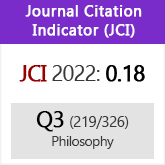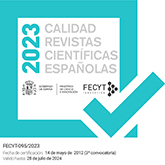Metaphor and Ethnic Terrorism
DOI:
https://doi.org/10.3989/isegoria.2012.046.04Keywords:
Terrorism, terrorist discourse, cognitive frames, cognitive theory of metaphorAbstract
The terrorist discourse has been critically analysed with the traditional tools provided by the discourse analysis, the argumentation theory and, broadly speaking, by rhetoric. This paper proposes rather a critical analysis of the ethnic terrorist or nationalist discourse that makes use of the contemporary theory of metaphor to reveal the cognitive frames that ascribes sense to the terrorist language, particularly the discourse used the ETA organization as the Basque nationalist and independentist discourse in general. This approach allows overcoming the shortcomings of the classical rhetorical tools, with its focus in the lexical or argumentative analysis, and gives an explanation of the mental settings characteristic of this kind of terrorist discourse.
Downloads
References
Aranzadi, J. (1994): Milenarismo vasco, Madrid: Taurus.
Billig, M. (1995): Banal Nationalism, Londres: Sage.
Bollinger, D. (1980): Language, the Loaded Weapon, the Use and Abuse of Language Today, Londres: Longman.
Bustos, E. (2000): La metáfora: ensayos transdisciplinares, Madrid: F.C.E.
Calleja, J. M. (2006): Algo habrá hecho: odio, muerte y miedo en Euskadi, Madrid: Espasa.
Casquete, J. (2007): Agitando emociones. La apoteosis del héroe mártir en el nacionalismo vasco radical, Bilbao: Cuadernos Bakeaz.
Casquete, J. (2009a): Comunidades de muerte, Barcelona: Anthropos.
Casquete, J. (2009b): En el nombre de Euskalherria: la religión política del nacionalismo radical vasco, Madrid: Tecnos.
Evans, V. y Green, M. (2006): Cognitive Linguistics: an Introduction, Edimburgo: Edimburgh U. Press.
Juaristi, J. (1989): El linaje de Aitor, Madrid: Taurus.
Juaristi, J. (1997): El bucle melancólico, Madrid: Espasa.
Gibbs, R. (2006): Embodiment and cognitive science. New York: Cambridge University Press.
Johnson, M. (2007): The Meaning of the Body, Chicago: Chicago U. Press.
Lakoff, G. y Johnson, M. (1999): Philosophy in the Flesh, Chicago: Chicago U. Press.
Lakoff, G. (2004[2007]): Don't think of an Elephant, Chelsea Green Publishing. Traducción al español: No pienses en un elefante, Madrid: Ed. Complutense, 200.
Lakoff, G. (2008): «The neural theory of metaphor», en R. Gibbs, ed., The Cambridge Hand-book of Metaphor and Thought, Cambridge: Cambridge U. Press, 17-38.
Lakoff, G. (2011): «Beyond the War on Terror: Understanding Reflexive Thought», en K._L. Carrington y S. Griffin, eds. (2011), Transforming Terror, Berkeley: U. of California Press, 43-46.
Macagno, F y Walton, D. (2010): «The argumentative Uses of Emotive Language», Revista Iberoamericana de Argumentación, vol. 1, n.º 1.
Sandler, T. y Arce, D. G. (2003): «Terrorism and Game Theory», Simulation and Gaming, 34, 319-337. http://dx.doi.org/10.1177/1046878103255492
Reddy, M. (1979): «The conduit metaphor», en A. Ortony, ed., Metaphor and Thought, Cambridge: Cambridge U. Press, 1979.
Reinares, F. (2001): Patriotas de la muerte. Quiénes han militado en ETA y por qué, Madrid: Taurus.
Sandler, T. y Siqueira, K. (2009): «Games and terrorism: Recent developments», Simulation and Gaming, 40, 164-192. http://dx.doi.org/10.1177/1046878108314772
Sanmartín, J. (2005): El terrorista. Cómo es. Cómo se hace. Barcelona: Ariel.
Steuter, E. y Wills, D. (2008): At War with Metaphor, Nueva York: Rowman and Littlefield.
Victoroff, J. y A. Kruglansky, eds. (2009): Psychology of Terrorism. Key Readings, Nueva York: Taylor & Francis.
Thagard, P. (2000): Coherence in Thought and Action, Cambridge, Mass.: MIT Press.
Walton, D. (2006): Fundamentals of Critical Argumentation, Cambridge: Cambridge U. Press.
Zulaika, J. (2009): Terrorism: the Self-fulfilling Prophecy, Chicago: Chicago U. Press.
Downloads
Published
How to Cite
Issue
Section
License
Copyright (c) 2012 Consejo Superior de Investigaciones Científicas (CSIC)

This work is licensed under a Creative Commons Attribution 4.0 International License.
© CSIC. Manuscripts published in both the printed and online versions of this Journal are the property of Consejo Superior de Investigaciones Científicas, and quoting this source is a requirement for any partial or full reproduction.All contents of this electronic edition, except where otherwise noted, are distributed under a “Creative Commons Attribution 4.0 International” (CC BY 4.0) License. You may read here the basic information and the legal text of the license. The indication of the CC BY 4.0 License must be expressly stated in this way when necessary.
Self-archiving in repositories, personal webpages or similar, of any version other than the published by the Editor, is not allowed.














